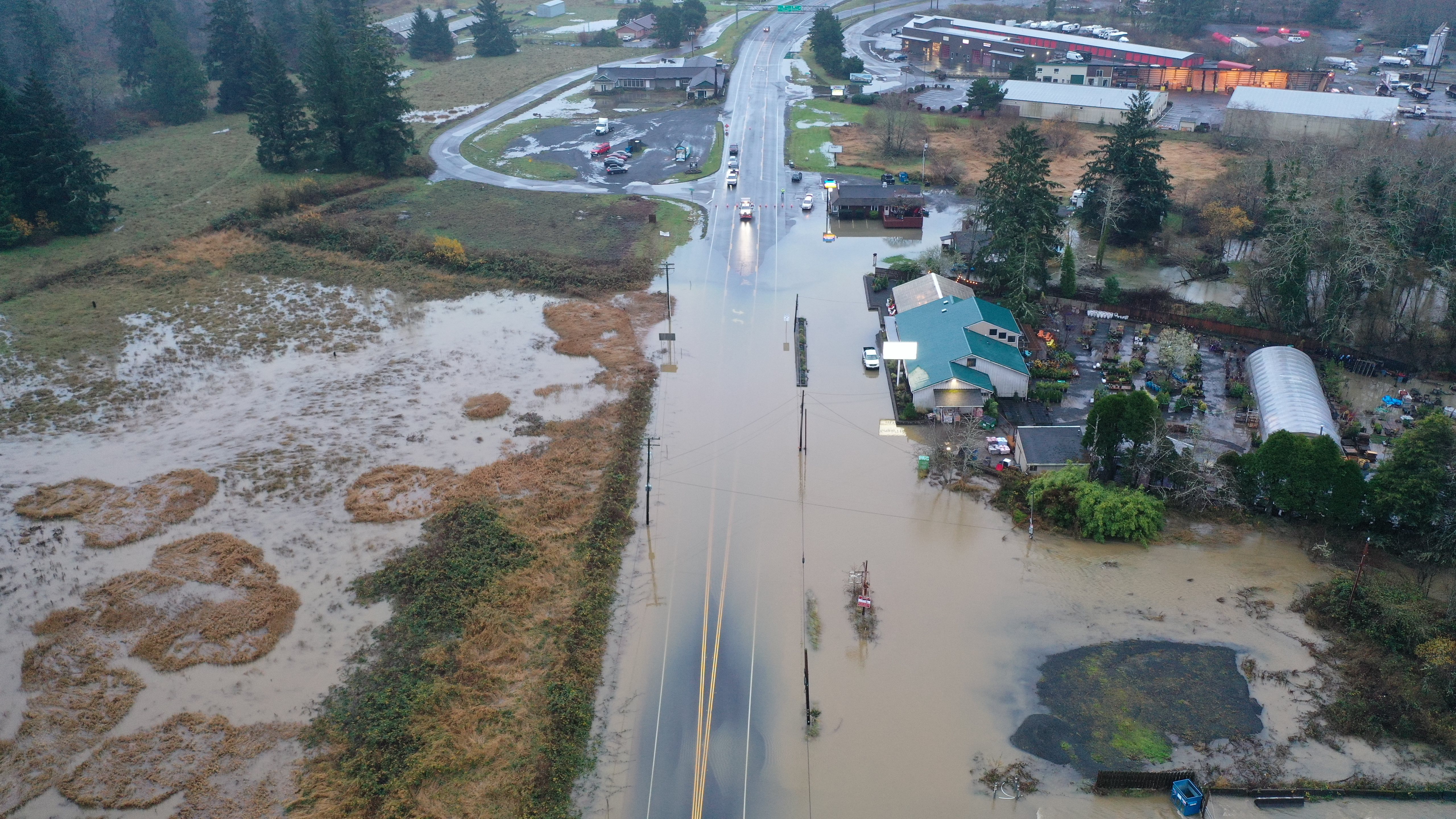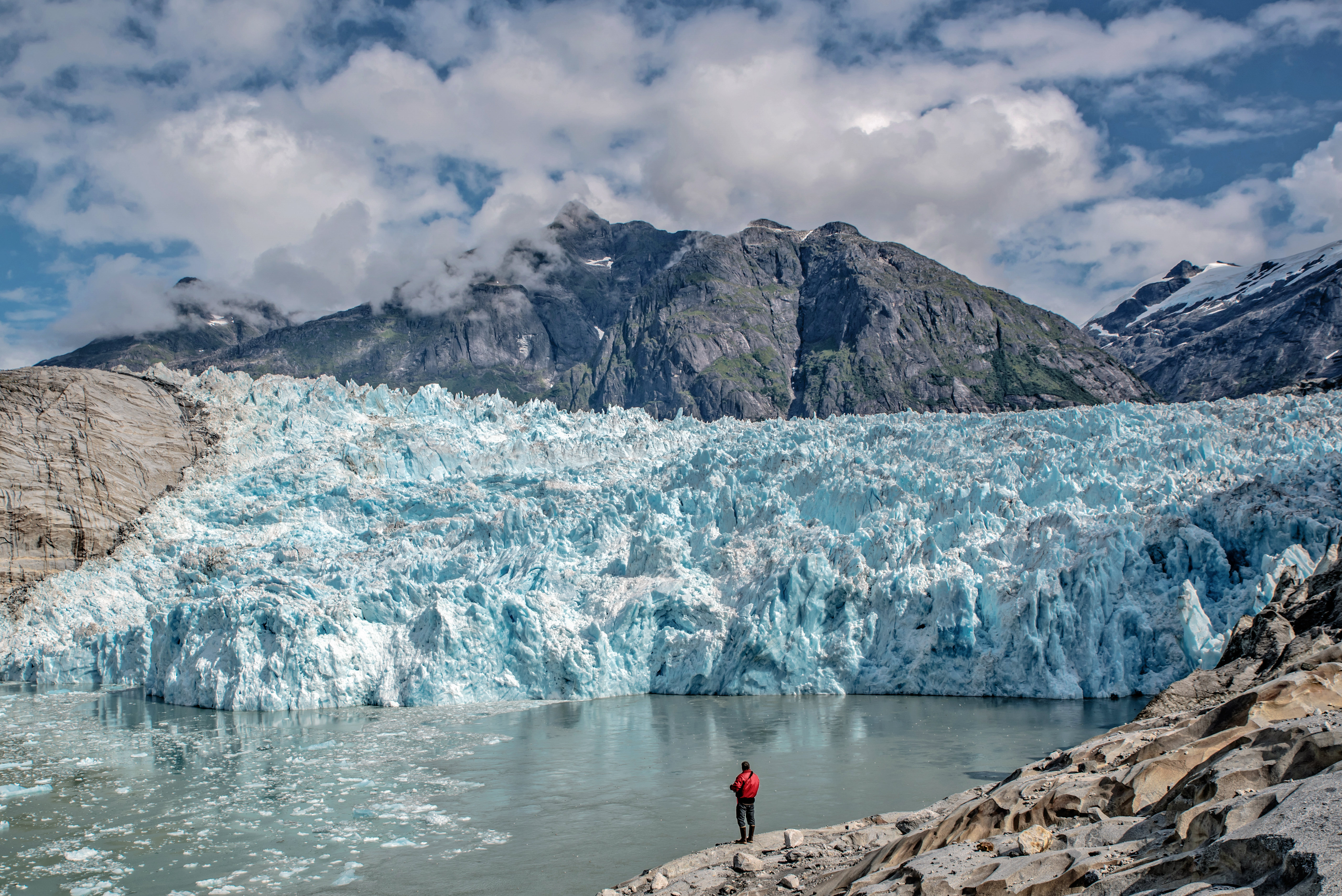Estimated reading time: 7 minutes
Key points:
- Climate change affects the region in different ways due to the large geographic area that spans different climates.
- Temperatures have warmed by 2-3° F since 1900 throughout the region.
- More precipitation is now falling as rain instead of snow, which is reducing snowpack in much of the region.
- Extreme events like droughts, floods, wildfires, and heat waves are occurring more often.
- Glaciers are melting, permafrost thaw is increasing, and breakup of river and sea ice is occurring earlier in the year.

Scaling down the global process of climate change to specific locations can be challenging. Because the Northwest Climate Hub region is diverse and expansive - containing everything from the highest peak in the United States (Denali) to dry sagebrush steppe - the effects of climate change differ throughout Alaska, Idaho, Oregon, and Washington.
Globally, atmospheric carbon dioxide levels have risen 50% since 1850, causing changes in temperature and an increase in extreme events such as floods and heatwaves throughout the Northwest. As temperatures rise, precipitation patterns change, and extreme events intensify, natural resources in the Northwest could experience increasingly negative effects. This article outlines climate change impacts that have already occurred, changes that are expected to occur in the future, and resources for climate mitigation and adaptation.
What has already changed in Alaska, Idaho, Oregon, and Washington?
Warming Temperatures
The Northwest has already experienced long-term warming. The annual average temperature has risen nearly 2˚F since 1900 in Idaho, Oregon and Washington. Alaska has warmed faster than any other state, with increases ranging from 2.4°F in Southeast Alaska to 6.2°F in northern Alaska. Some of the hottest years on record have occurred over the last 20 years. Oregon and Washington had their hottest year in 2015. Idaho’s hottest year was 1934, with 2015 trailing closely behind. 2016 and 2019 were the second hottest and hottest years on record in Alaska. All but five of the years from 1980-2011 were warmer than the average annual temperature from 1900 to 1960.
Precipitation
Precipitation trends are changing throughout the region. In Idaho, Oregon, and Washington, recent years have seen a reduction in summer precipitation and an increase in winter and spring precipitation. More winter precipitation is now falling as rain rather than snow due to warmer temperatures. Because precipitation varies widely across Alaska, determining trends across the entire state is difficult. However, portions of Interior and Arctic Alaska have experienced a long-term decrease in precipitation.
Snowpack is also changing. Snowpack is the seasonal accumulation of snowfall that melts in late spring and summer, releasing into streams, rivers, lakes, and reservoirs over time. In Idaho, Oregon, and Washington, warmer temperatures have reduced the overall snowpack and caused earlier spring snowmelt. In Alaska, snow is also melting earlier, reducing snow cover for vulnerable plants and permafrost. Changes in snowpack and precipitation affect agriculture, infrastructure, forests, and rangelands.
Drought is an ongoing, climate-related issue throughout the Northwest. Idaho, Oregon, and Washington have experienced multiple droughts since 2000, and are projected to experience more drought with climate change. Parts of Alaska have also experienced extreme drought recently.
Extreme Events
Floods, heat waves, cold snaps, high winds, droughts, and extreme precipitation have all been recorded in increasing numbers in the Northwest. Larger atmospheric rivers—thick bands of air that transport large amounts of moisture north from the tropics—have caused increased flooding and heavy winds.
Wildfires

Increasing temperatures, drought, reduced snowpack, and extreme fire weather have heightened the risk of large and severe wildfires in Idaho, Oregon, and Washington. Fire seasons are beginning earlier in the year and ending later, and ignitions are occurring in ecosystems that have not experienced fire in many decades. Meanwhile, increasingly common nighttime heat events heighten the severity of wildfires.
In Alaska, warmer, drier summers have led to a greater number of large fires over the last 20 years, including reburns of recently burned areas. From 2000 to 2020, the frequency of large seasons (more than 2000 square miles burned) more than doubled compared to 1955–1999.
Oceans
Ocean temperatures in the northeast Pacific Ocean have warmed considerably, causing algal blooms, increased ocean acidification, and challenges for salmon and other aquatic species. Shellfish in Washington, Oregon, and Alaska are particularly vulnerable to ocean acidification. Warming temperatures have caused sea level to rise in parts of Alaska, Oregon, and Washington, increasing coastal erosion. Sea level is expected to rise another 1–4 feet by 2100. However, along the southern coast of Alaska, sea level has fallen due to rising ground from ice mass lost to thawing.
Less Ice: Glaciers, Permafrost, Rivers, Seas
Across the region glaciers are melting, which can affect hydropower, streamflow, infrastructure, and public health. In Alaska, glaciers are melting twice as fast now as they did from 1960 to 2004. Glaciers are expected to completely disappear from the Olympic Peninsula in Washington by 2070, which could affect water resources in the region.
Permafrost—rock or soil that stays frozen for two or more years—is found beneath 80 percent of ground in Alaska and plays a significant role in its ecology and infrastructure. Permafrost is also the planet’s largest terrestrial carbon sink. As temperatures increase, more permafrost will thaw, leading to land caving or sinking, and damaged infrastructure. This kind of damage has already forced several communities in Alaska to relocate. In addition, permafrost thawing releases methane and carbon dioxide, greenhouse gases that contribute to further climate change.

River ice breakup is also affected by climate change in Alaska. River ice breakup now occurs 7–9 days earlier than it did 120 years ago. In rural and remote Alaska, surface transportation infrastructure is very limited. Ice offers an alternative for transporting people and goods. As the climate warms, a shorter cold season will reduce the season length for ice road use and increase the risk of travel on river ice. Early ice breakup affects many Alaskan communities that depend on the predictability of frozen or unfrozen rivers for subsistence hunting, fishing, and community connection. Early or rapid thawing can cause severe flooding and damage to infrastructure.
Arctic sea ice extent and thickness have decreased substantially over the last few decades. Arctic sea ice helps to maintain consistently cool Arctic temperatures by reflecting warming sunlight back into the atmosphere. As sea ice decreases, that warming sunlight is absorbed into the ocean, causing ocean warming, heightened air temperatures, and increased carbon dioxide absorption which can lead to acidification. Warming temperatures that minimize sea ice extent result in storm surges, coastal flooding, and coastal erosion. Several rural communities have been forced to relocate due to these changes. Subsistence hunting and fishing are also affected by shifts in sea ice. The lowest minimum sea ice extent occurred in 2012, with the second lowest in 2020.
What do we expect to change in the future?

Although the rate of climate change depends on the future rate of greenhouse gas emissions, the Northwest Climate Hub region (along with the entire globe) is expected to continue to warm under all future climate scenarios. High-elevation areas are expected to warm at a faster rate than lower elevation areas. This will result in further snowpack loss, earlier snowmelt, and increased risk for insect outbreaks, especially in stressed vegetation. Higher temperatures will affect water basins with significant snowmelt contributions to streamflow and could affect drinking water, agricultural water for irrigation, recreation, and ecosystems. For example, fish spawning could be disrupted if changes in snowpack or snowmelt alter the timing and abundance of streamflow. Higher temperatures and earlier snowmelt will likely facilitate earlier wildfires and increase area burned by wildfires in some places.
Climate change projections for the end of the century suggest an increase in average annual temperature of 4.7–10°F in Idaho, Oregon, and Washington, and 2–15°F in Alaska, with temperature ranges depending on emission scenarios. Precipitation projections are more uncertain than those for temperature. For Idaho, Oregon, and Washington, there is potential for a slight increase in precipitation in winter, lower summer precipitation, and more extreme precipitation events. Precipitation in Alaska is expected to increase 20.6% by the end of the century under an intermediate emissions scenario relative to 1981–2010. More extreme precipitation events are also likely. By 2050, annual precipitation increases are projected to reach 10 percent over most of the state. Lower snowpack is expected in much of the Northwest, with more precipitation falling as rain than snow, and snowpack melting earlier, resulting in longer dry seasons. Higher temperatures and longer periods between precipitation events are expected to lead to more frequent and severe droughts.
Climate variability is likely to increase in the Northwest, meaning that periods of long drought will be interspersed with years of heavy precipitation, and occasionally, major flooding like Washington experienced in November 2021. Years of below-average precipitation and drought conditions are expected to continue throughout the century, and extreme events, like heavy rainfall associated with atmospheric rivers, are also anticipated to occur more often.
Along the coast, severe winter storms are also likely to increase and contribute to storm surges, large waves, coastal erosion, and flooding in coastal areas. Changes in atmospheric rivers could cause heavy winds and extreme precipitation events to increase by 50 percent over the century. Warmer ocean waters, changing water chemistry, sea level rise, and shifts in marine species composition and food webs are also expected.
Climate Mitigation and Adaptation
The climate has changed and is projected to continue to change in the Northwest. There are tools that we can use to mitigate and adapt to the changing climate. The Northwest Climate Hub has examples and case studies that highlight climate adaptation in progress and in practice. Check out the Northwest Climate Hub’s Management Actions to learn more about some of the tools and practices. In addition, many communities and regions in the Northwest have developed Climate Change Adaptation Plans.
The Northwest Climate Hub provides Climate Adaptation Resources for Northwest Forests, Climate Adaptation Resources for Northwest Agriculture, and Climate Adaptation Resources for Northwest Rangelands to aid foresters, agricultural producers, ranchers, and natural resource managers in adapting to climate change.
U.S. Environmental Protection Agency (EPA): Basics of Climate Change
University of Washington Climate Impacts Group: Climate Change
Regional
The Northwest Climate Adaptation Science Center provides information about climate impacts, adaptation, and resilience in Idaho, Oregon, and Washington.
The Northwest Chapter of the Fifth National Climate Assessment includes key messages, background, and impacts to Idaho, Oregon, and Washington.
Alaska
The Alaska State Climate Summary provides key messages and detailed information about the effects of climate change in Alaska.
The Alaska Chapter of the Fifth National Climate Assessment includes key messages, background, and impacts to the Alaska region.
Alaska Climate Adaptation Science Center provides information about climate impacts, adaptation, and resilience in Alaska.
Idaho
The Idaho State Climate Summary provides key messages and detailed information about the effects of climate change in Idaho.
The University of Idaho maintains a page on climate change research and impacts in Idaho.
Oregon
The Oregon State Climate Summary provides key messages and detailed information about the effects of climate change in Idaho.
The Oregon Climate Change Research Institute provides assessments on climate change in Oregon, adaptation tools, and research.
Washington
The Washington State Climate Summary provides key messages and detailed information about the effects of climate change in Washington.
Washington State University Department of Ecology: Climate Change
-
Alaska and a Changing Climate
Rapid warming and changing precipitation patterns in Alaska affect communities, industry, and natural resources.
-
Climate Change and Wildfire in Idaho, Oregon, and Washington
Large fires in Idaho, Oregon, and Washington are associated with warm and dry conditions that are likely to increase with climate change.
-
Climate Change and Mental Health in the Northwest
Climate change can have a variety of negative mental health effects, particularly on vulnerable populations. However, there are ways to increase our resilience…




